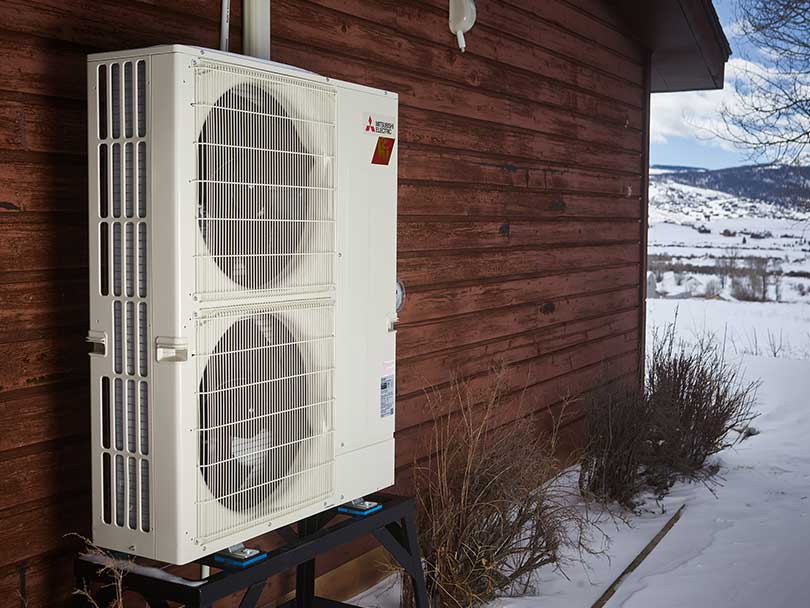By Amy Higgins
Colorado’s electric cooperatives have a reputation of staying on top of innovation and energy efficiency, and while they aren’t new to the beneficial electricity market, advancements and innovations in heat pumps are.
Lowering Your Carbon Footprint
The cold-climate, air source heat pump (ccASHP) is one of the latest innovations in beneficial electrification. These products can reduce air pollution and energy costs by switching from direct fossil fuels, like propane or natural gas, to electric resources that emit less carbon emissions.
“Overall, [ccASHPs] emit less carbon per unit of heat than burning fossil fuels,” explains Tri-State Generation and Transmission Relationship Manager Peter Rusin. “As [Tri-State] implements its Responsible Energy Plan, over the next four years and over the next 10, that gap is only going to grow compared to propane and natural gas — that’s going to be much better for the environment.”
Modernizing Heat Pumps
Unlike the heat pumps of years past, innovations in heat pumps today include variable speed, or inverter, technology that allows them to operate over a wider range of temperatures.
“So, instead of going down to 40 or 35 degrees where that heat pump is working before you need a backup, now we’re seeing systems get down to negative 13, negative 20,” Rusin explains. He says this variable speed technology can either eliminate or reduce the need for a backup because of the unit’s ability to carry temperatures much deeper into the extremely cold range, meaning it’s possible that it can be used as a primary heat source.
Benefits of ccASHPs
Granby-based Mountain Parks Electric, the National Rural Electric Cooperative Association and Xergy Consulting recently conducted a pilot study of three homes in the Fraser area in which the homes were outfitted with ccASHPs.
The study showed that one 2-ton ccASHP unit reduced total annual heating costs by approximately 30%. (Visit mpei.com/pilot-programs to read the complete findings.)
These ccASHPs are not only friendlier to the environment, but they are also more cost effective than a propane furnace or resistance baseboard system and safer to operate seeing as you’re essentially eliminating ignitable vapors in your home.
“Any time you burn a fossil fuel, you can create carbon monoxide, carbon dioxide, hydrocarbons — all these things that really impact your indoor air quality,” says Mike Frailey, relationship manager at Tri-State. “Switching to an air source heat pump eliminates that [emission] from your propane or natural gas furnace. There’s a reduction in the CO2 emissions from an exhaust standpoint, too, such as a chimney.”
Businesses Embracing Innovations in Heat Pumps
Frailey and Rusin share that they’re also seeing commercial interest in ccASHPs. For example, they’re working with a school in Wyoming that is interested in adding 55-tons of heat pump technology to replace a steam boiler system, and state rebates and educated resources could help them cut costs.
Frailey adds, “In that specific application, it’s going to be a mix of split systems for some smaller rooms and then they’re doing three 8½-ton packaged rooftop units, so there are commercial applications and it seems it’s going to continue to evolve and grow.”
Soothing Skeptics’ Hesitations
However, while the innovations in heat pumps are enticing, the upfront cost of a few grand or more might be a drawback for some.
To relieve Colorado’s electric cooperative consumer-members of the cost burden, Tri-State offers a $450 rebate per ton for a new ccASHP and some of Colorado’s electric cooperatives offer rebates of their own.
MPE, for example, offers a rebate of $500 per ton, which could mean $3,000 or more off the consumer’s bottom line when combined with Tri-State’s rebate.
Keeping Coloradans Comfortable
Several Colorado towns are some of the coldest in the nation during the winter, but innovation in the energy sector and a commitment to provide electric co-op consumer-members the safest, most reliable service at the lowest cost possible is at the forefront of every co-op in the state. Products such as ccASHPs can keep Coloradans safe and comfortable during some of the coldest times.
To learn more about ccASHPs, contact your local cooperative. They can assist you in finding knowledgeable contractors to get the job done correctly, rebates to help your bottom line and information on how to stay comfortable in the dead of winter — they are the trusted resources.
Amy Higgins is an award-winning writer who has been writing for Colorado Country Life for nearly a decade, staying up to date on the latest innovations and changes in the electric co-op industry.

